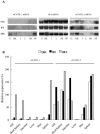Two cathelicidin genes are present in both rainbow trout (Oncorhynchus mykiss) and atlantic salmon (Salmo salar)
- PMID: 16377685
- PMCID: PMC1346769
- DOI: 10.1128/AAC.50.1.185-195.2006
Two cathelicidin genes are present in both rainbow trout (Oncorhynchus mykiss) and atlantic salmon (Salmo salar)
Abstract
Further to the previous finding of the rainbow trout rtCATH_1 gene, this paper describes three more cathelicidin genes found in salmonids: two in Atlantic salmon, named asCATH_1 and asCATH_2, and one in rainbow trout, named rtCATH_2. All the three new salmonid cathelicidin genes share the common characteristics of mammalian cathelicidin genes, such as consisting of four exons and possessing a highly conserved preproregion and four invariant cysteines clustered in the C-terminal region of the cathelin-like domain. The asCATH_1 gene is homologous to the rainbow trout rtCATH_1 gene, in that it possesses three repeat motifs of TGGGGGTGGC in exon IV and two cysteine residues in the predicted mature peptide, while the asCATH_2 gene and rtCATH_2 gene are homologues of each other, with 96% nucleotide identity. Salmonid cathelicidins possess the same elastase-sensitive residue, threonine, as hagfish cathelicidins and the rabbit CAP18 molecule. The cleavage site of the four salmonid cathelicidins is within a conserved amino acid motif of QKIRTRR, which is at the beginning of the sequence encoded by exon IV. Two 36-residue peptides corresponding to the core part of rtCATH_1 and rtCATH_2 were chemically synthesized and shown to exhibit potent antimicrobial activity. rtCATH_2 was expressed constitutively in gill, head kidney, intestine, skin and spleen, while the expression of rtCATH_1 was inducible in gill, head kidney, and spleen after bacterial challenge. Four cathelicidin genes have now been characterized in salmonids and two were identified in hagfish, confirming that cathelicidin genes evolved early and are likely present in all vertebrates.
Figures








Similar articles
-
Identification of a novel cathelicidin gene in the rainbow trout, Oncorhynchus mykiss.Infect Immun. 2005 Aug;73(8):5053-64. doi: 10.1128/IAI.73.8.5053-5064.2005. Infect Immun. 2005. PMID: 16041021 Free PMC article.
-
Identification and expression analysis of two interleukin-23α (p19) isoforms, in rainbow trout Oncorhynchus mykiss and Atlantic salmon Salmo salar.Mol Immunol. 2015 Aug;66(2):216-28. doi: 10.1016/j.molimm.2015.03.014. Epub 2015 Apr 1. Mol Immunol. 2015. PMID: 25841173
-
Genomic organisation analysis of novel immunoglobulin-like transcripts in Atlantic salmon (Salmo salar) reveals a tightly clustered and multigene family.BMC Genomics. 2010 Dec 9;11:697. doi: 10.1186/1471-2164-11-697. BMC Genomics. 2010. PMID: 21143889 Free PMC article.
-
Cathelicidin family of antimicrobial peptides: proteolytic processing and protease resistance.Bioorg Chem. 2003 Dec;31(6):425-36. doi: 10.1016/s0045-2068(03)00080-4. Bioorg Chem. 2003. PMID: 14613764 Review.
-
The cathelicidins--structure, function and evolution.Curr Protein Pept Sci. 2005 Feb;6(1):23-34. doi: 10.2174/1389203053027520. Curr Protein Pept Sci. 2005. PMID: 15638766 Review.
Cited by
-
Structural and functional analysis of the pro-domain of human cathelicidin, LL-37.Biochemistry. 2013 Mar 5;52(9):1547-58. doi: 10.1021/bi301008r. Epub 2013 Feb 21. Biochemistry. 2013. PMID: 23406372 Free PMC article.
-
A Comparison of the Innate and Adaptive Immune Systems in Cartilaginous Fish, Ray-Finned Fish, and Lobe-Finned Fish.Front Immunol. 2019 Oct 10;10:2292. doi: 10.3389/fimmu.2019.02292. eCollection 2019. Front Immunol. 2019. PMID: 31649660 Free PMC article. Review.
-
Raptor/mTORC1 Acts as a Modulatory Center to Regulate Anti-bacterial Immune Response in Rockfish.Front Immunol. 2019 Dec 18;10:2953. doi: 10.3389/fimmu.2019.02953. eCollection 2019. Front Immunol. 2019. PMID: 31921198 Free PMC article.
-
Transcriptomic Profiling in Fins of Atlantic Salmon Parasitized with Sea Lice: Evidence for an Early Imbalance Between Chalimus-Induced Immunomodulation and the Host's Defense Response.Int J Mol Sci. 2020 Mar 31;21(7):2417. doi: 10.3390/ijms21072417. Int J Mol Sci. 2020. PMID: 32244468 Free PMC article.
-
Physiological and Biochemical Characteristics of Rainbow Trout with Severe, Moderate and Asymptomatic Course of Vibrio anguillarum Infection.Animals (Basel). 2022 Oct 1;12(19):2642. doi: 10.3390/ani12192642. Animals (Basel). 2022. PMID: 36230384 Free PMC article.
References
-
- Barnes, A. C., C. Guyot, B. G. Hanse, K. Mackenzie, M. T. Horn, and A. E. Ellis. 2002. Resistance to serum killing may contribute to differences in the abilities of capsulate and non-capsulated isolates of Lactococcus garvieae to cause disease in rainbow trout (Oncorhynchus mykiss L.). Fish Shellfish Immunol. 12:155-168. - PubMed
-
- Boesen, H. T., M. H. Larsen, J. L. Larsen, and A. E. Ellis. 2001. In vitro interactions between rainbow trout (Oncorhynchus mykiss) macrophages and Vibrio anguillarum serogroup O2a. Fish Shellfish Immunol. 11:415-431. - PubMed
Publication types
MeSH terms
Substances
LinkOut - more resources
Full Text Sources

